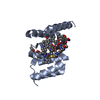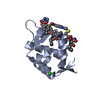[English] 日本語
 Yorodumi
Yorodumi- PDB-8f0z: Structure of the MDM2 P53 binding domain in complex with H101, an... -
+ Open data
Open data
- Basic information
Basic information
| Entry | Database: PDB / ID: 8f0z | ||||||||||||
|---|---|---|---|---|---|---|---|---|---|---|---|---|---|
| Title | Structure of the MDM2 P53 binding domain in complex with H101, an all-D Helicon Polypeptide | ||||||||||||
 Components Components |
| ||||||||||||
 Keywords Keywords | LIGASE / E3 ligase / D-peptide / stapled peptide | ||||||||||||
| Function / homology |  Function and homology information Function and homology informationcellular response to vitamin B1 / response to formaldehyde / response to water-immersion restraint stress / response to ether / traversing start control point of mitotic cell cycle / atrial septum development / regulation of protein catabolic process at postsynapse, modulating synaptic transmission / fibroblast activation / Trafficking of AMPA receptors / receptor serine/threonine kinase binding ...cellular response to vitamin B1 / response to formaldehyde / response to water-immersion restraint stress / response to ether / traversing start control point of mitotic cell cycle / atrial septum development / regulation of protein catabolic process at postsynapse, modulating synaptic transmission / fibroblast activation / Trafficking of AMPA receptors / receptor serine/threonine kinase binding / peroxisome proliferator activated receptor binding / negative regulation of intrinsic apoptotic signaling pathway by p53 class mediator / positive regulation of vascular associated smooth muscle cell migration / negative regulation of protein processing / SUMO transferase activity / response to steroid hormone / response to iron ion / atrioventricular valve morphogenesis / AKT phosphorylates targets in the cytosol / NEDD8 ligase activity / cellular response to peptide hormone stimulus / endocardial cushion morphogenesis / ventricular septum development / positive regulation of muscle cell differentiation / cardiac septum morphogenesis / regulation of postsynaptic neurotransmitter receptor internalization / blood vessel development / SUMOylation of ubiquitinylation proteins / cellular response to alkaloid / ligase activity / Constitutive Signaling by AKT1 E17K in Cancer / regulation of protein catabolic process / negative regulation of DNA damage response, signal transduction by p53 class mediator / negative regulation of signal transduction by p53 class mediator / SUMOylation of transcription factors / response to magnesium ion / cellular response to UV-C / protein sumoylation / cellular response to estrogen stimulus / blood vessel remodeling / cellular response to actinomycin D / protein localization to nucleus / ribonucleoprotein complex binding / protein autoubiquitination / positive regulation of vascular associated smooth muscle cell proliferation / NPAS4 regulates expression of target genes / transcription repressor complex / positive regulation of mitotic cell cycle / regulation of heart rate / : / ubiquitin binding / positive regulation of protein export from nucleus / response to cocaine / DNA damage response, signal transduction by p53 class mediator / establishment of protein localization / Stabilization of p53 / Regulation of RUNX3 expression and activity / cellular response to gamma radiation / Oncogene Induced Senescence / RING-type E3 ubiquitin transferase / protein destabilization / Regulation of TP53 Activity through Methylation / cellular response to growth factor stimulus / response to toxic substance / centriolar satellite / cellular response to hydrogen peroxide / protein polyubiquitination / disordered domain specific binding / ubiquitin-protein transferase activity / p53 binding / ubiquitin protein ligase activity / endocytic vesicle membrane / Signaling by ALK fusions and activated point mutants / Regulation of TP53 Degradation / positive regulation of proteasomal ubiquitin-dependent protein catabolic process / negative regulation of neuron projection development / protein-containing complex assembly / 5S rRNA binding / ubiquitin-dependent protein catabolic process / Oxidative Stress Induced Senescence / cellular response to hypoxia / Regulation of TP53 Activity through Phosphorylation / amyloid fibril formation / proteasome-mediated ubiquitin-dependent protein catabolic process / regulation of cell cycle / Ub-specific processing proteases / postsynaptic density / protein ubiquitination / response to xenobiotic stimulus / protein domain specific binding / response to antibiotic / negative regulation of DNA-templated transcription / positive regulation of cell population proliferation / apoptotic process / ubiquitin protein ligase binding / positive regulation of gene expression / negative regulation of apoptotic process / nucleolus / glutamatergic synapse / enzyme binding Similarity search - Function | ||||||||||||
| Biological species |  Homo sapiens (human) Homo sapiens (human)synthetic construct (others) | ||||||||||||
| Method |  X-RAY DIFFRACTION / X-RAY DIFFRACTION /  SYNCHROTRON / SYNCHROTRON /  MOLECULAR REPLACEMENT / Resolution: 1.61 Å MOLECULAR REPLACEMENT / Resolution: 1.61 Å | ||||||||||||
 Authors Authors | Li, K. / Callahan, A.J. / Travaline, T.L. / Tokareva, O.S. / Swiecicki, J.-M. / Verdine, G.L. / Pentelute, B.L. / McGee, J.H. | ||||||||||||
| Funding support |  United States, United States,  Germany, 3items Germany, 3items
| ||||||||||||
 Citation Citation |  Journal: Chemrxiv / Year: 2023 Journal: Chemrxiv / Year: 2023Title: Single-Shot Flow Synthesis of D-Proteins for Mirror-Image Phage Display Authors: Callahan, A.J. / Gandhesiri, S. / Travaline, T.L. / Lozano Salazar, L. / Hanna, S. / Lee, Y.-C. / Li, K. / Tokareva, O.S. / Swiecicki, J.-M. / Loas, A. / Verdine, G.L. / McGee, J.H. / Pentelute, B.L. | ||||||||||||
| History |
|
- Structure visualization
Structure visualization
| Structure viewer | Molecule:  Molmil Molmil Jmol/JSmol Jmol/JSmol |
|---|
- Downloads & links
Downloads & links
- Download
Download
| PDBx/mmCIF format |  8f0z.cif.gz 8f0z.cif.gz | 42.5 KB | Display |  PDBx/mmCIF format PDBx/mmCIF format |
|---|---|---|---|---|
| PDB format |  pdb8f0z.ent.gz pdb8f0z.ent.gz | 26.1 KB | Display |  PDB format PDB format |
| PDBx/mmJSON format |  8f0z.json.gz 8f0z.json.gz | Tree view |  PDBx/mmJSON format PDBx/mmJSON format | |
| Others |  Other downloads Other downloads |
-Validation report
| Summary document |  8f0z_validation.pdf.gz 8f0z_validation.pdf.gz | 450.6 KB | Display |  wwPDB validaton report wwPDB validaton report |
|---|---|---|---|---|
| Full document |  8f0z_full_validation.pdf.gz 8f0z_full_validation.pdf.gz | 451.5 KB | Display | |
| Data in XML |  8f0z_validation.xml.gz 8f0z_validation.xml.gz | 7.3 KB | Display | |
| Data in CIF |  8f0z_validation.cif.gz 8f0z_validation.cif.gz | 9.2 KB | Display | |
| Arichive directory |  https://data.pdbj.org/pub/pdb/validation_reports/f0/8f0z https://data.pdbj.org/pub/pdb/validation_reports/f0/8f0z ftp://data.pdbj.org/pub/pdb/validation_reports/f0/8f0z ftp://data.pdbj.org/pub/pdb/validation_reports/f0/8f0z | HTTPS FTP |
-Related structure data
| Related structure data |  8f10C  8f12C  8f13C  8f14C  8f15C  8f16C  8f17C  3g03S S: Starting model for refinement C: citing same article ( |
|---|---|
| Similar structure data | Similarity search - Function & homology  F&H Search F&H Search |
- Links
Links
- Assembly
Assembly
| Deposited unit | 
| |||||||||
|---|---|---|---|---|---|---|---|---|---|---|
| 1 |
| |||||||||
| Unit cell |
| |||||||||
| Components on special symmetry positions |
|
- Components
Components
| #1: Protein | Mass: 11099.000 Da / Num. of mol.: 1 Source method: isolated from a genetically manipulated source Source: (gene. exp.)  Homo sapiens (human) / Gene: MDM2 / Production host: Homo sapiens (human) / Gene: MDM2 / Production host:  References: UniProt: Q00987, RING-type E3 ubiquitin transferase |
|---|---|
| #2: Polypeptide(D) | Mass: 1999.189 Da / Num. of mol.: 1 / Source method: obtained synthetically / Source: (synth.) synthetic construct (others) |
| #3: Chemical | ChemComp-CL / |
| #4: Chemical | ChemComp-WHL / |
| #5: Water | ChemComp-HOH / |
| Has ligand of interest | N |
| Has protein modification | Y |
-Experimental details
-Experiment
| Experiment | Method:  X-RAY DIFFRACTION / Number of used crystals: 1 X-RAY DIFFRACTION / Number of used crystals: 1 |
|---|
- Sample preparation
Sample preparation
| Crystal | Density Matthews: 2.22 Å3/Da / Density % sol: 44.59 % |
|---|---|
| Crystal grow | Temperature: 291 K / Method: vapor diffusion, sitting drop / pH: 7 / Details: 3.5 M Sodium Formate pH 7.0 |
-Data collection
| Diffraction | Mean temperature: 100 K / Serial crystal experiment: N |
|---|---|
| Diffraction source | Source:  SYNCHROTRON / Site: SYNCHROTRON / Site:  APS APS  / Beamline: 23-ID-B / Wavelength: 1.03319 Å / Beamline: 23-ID-B / Wavelength: 1.03319 Å |
| Detector | Type: DECTRIS EIGER X 16M / Detector: PIXEL / Date: Mar 31, 2021 |
| Radiation | Protocol: SINGLE WAVELENGTH / Monochromatic (M) / Laue (L): M / Scattering type: x-ray |
| Radiation wavelength | Wavelength: 1.03319 Å / Relative weight: 1 |
| Reflection | Resolution: 1.61→40.87 Å / Num. obs: 15696 / % possible obs: 99.6 % / Redundancy: 12.8 % / CC1/2: 0.998 / Rmerge(I) obs: 0.067 / Net I/σ(I): 19.3 |
| Reflection shell | Resolution: 1.61→1.64 Å / Redundancy: 12.9 % / Mean I/σ(I) obs: 2.1 / Num. unique obs: 774 / CC1/2: 0.774 / % possible all: 100 |
- Processing
Processing
| Software |
| ||||||||||||||||||
|---|---|---|---|---|---|---|---|---|---|---|---|---|---|---|---|---|---|---|---|
| Refinement | Method to determine structure:  MOLECULAR REPLACEMENT MOLECULAR REPLACEMENTStarting model: 3G03 Resolution: 1.61→40.87 Å / Cross valid method: THROUGHOUT
| ||||||||||||||||||
| Displacement parameters | Biso max: 95.8 Å2 / Biso mean: 35.5855 Å2 / Biso min: 18.36 Å2 | ||||||||||||||||||
| Refinement step | Cycle: LAST / Resolution: 1.61→40.87 Å
|
 Movie
Movie Controller
Controller


 PDBj
PDBj














